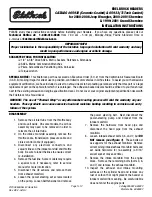
and controls the wheel spin across a driven axle. If one
wheel on a driven axle is spinning faster than the other, the
system will apply the brake of the spinning wheel. This
will allow more vehicle torque to be applied to the wheel
that is not spinning. BLD may remain enabled even if TCS
and ESC are in a reduced mode.
Electronic Stability Control (ESC)
This system enhances directional control and stability of
the vehicle under various driving conditions. ESC corrects
for oversteering or understeering of the vehicle by apply-
ing the brake of the appropriate wheel(s) to assist in
counteracting the oversteer or understeer condition. En-
gine power may also be reduced to help the vehicle
maintain the desired path.
ESC uses sensors in the vehicle to determine the vehicle
path intended by the driver and compares it to the actual
path of the vehicle. When the actual path does not match
the intended path, ESC applies the brake of the appropriate
wheel to assist in counteracting the oversteer or understeer
condition.
•
Oversteer — when the vehicle is turning more than
appropriate for the steering wheel position.
•
Understeer — when the vehicle is turning less than
appropriate for the steering wheel position.
The “ESC Activation/Malfunction Indicator Light” located
in the instrument cluster will start to flash as soon as the
ESC system becomes active. The “ESC Activation/
Malfunction Indicator Light” also flashes when the TCS is
active. If the “ESC Activation/Malfunction Indicator
Light” begins to flash during acceleration, ease up on the
accelerator and apply as little throttle as possible. Be sure to
adapt your speed and driving to the prevailing road
conditions.
WARNING!
•
Electronic Stability Control (ESC) cannot prevent the
natural laws of physics from acting on the vehicle,
nor can it increase the traction afforded by prevailing
road conditions. ESC cannot prevent accidents, in-
cluding those resulting from excessive speed in
turns, driving on very slippery surfaces, or hydro-
planing. ESC also cannot prevent accidents resulting
from loss of vehicle control due to inappropriate
driver input for the conditions. Only a safe, attentive,
(Continued)
5
SAFETY
161
Summary of Contents for Grand Caravan 2018
Page 4: ......
Page 8: ......
Page 14: ......
Page 130: ...INSTRUMENT CLUSTER Base Instrument Cluster 128 GETTING TO KNOW YOUR INSTRUMENT PANEL ...
Page 220: ...2nd Row Quad Seat LATCH Lower Anchorages 3rd Row 60 40 Seat LATCH Lower Anchorages 218 SAFETY ...
Page 259: ...Slow Tone Fast Tone 6 STARTING AND OPERATING 257 ...
Page 282: ......
Page 380: ......
Page 464: ...Voice Tree Main Menu 462 MULTIMEDIA ...
Page 465: ...Voice Tree Phonebook 10 MULTIMEDIA 463 ...
Page 466: ...Voice Tree Setup 464 MULTIMEDIA ...
Page 476: ......
Page 483: ...INDEX 12 ...
















































